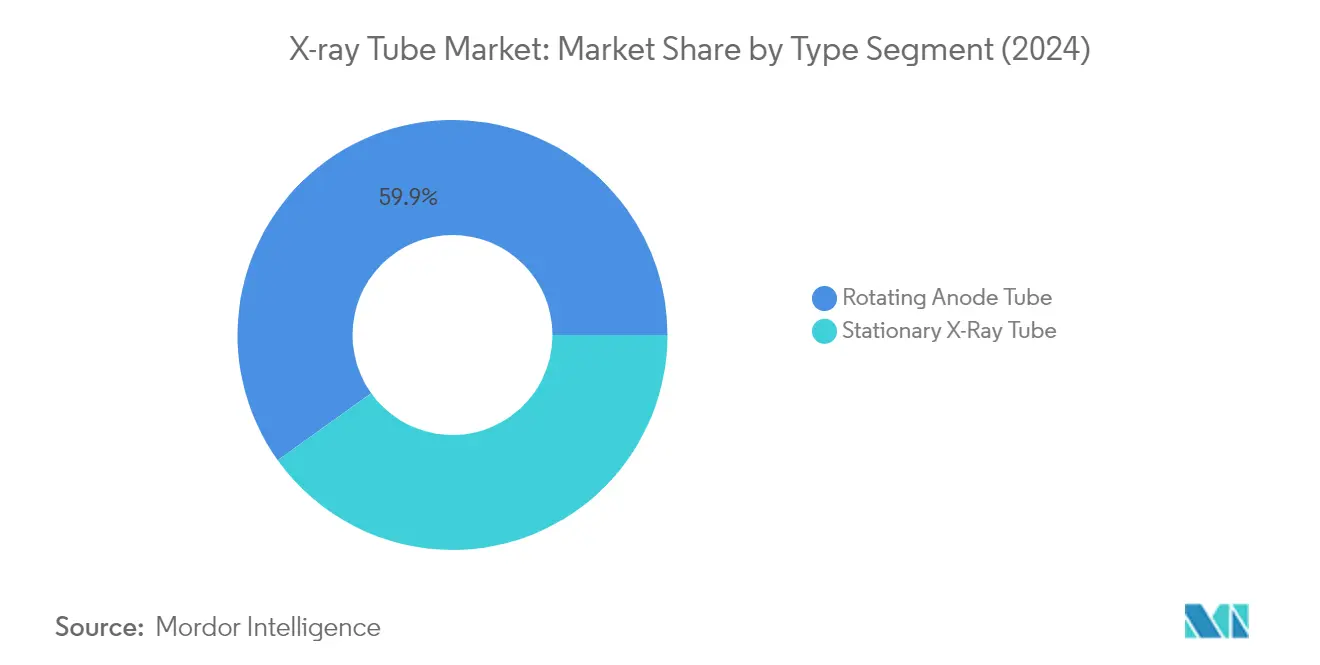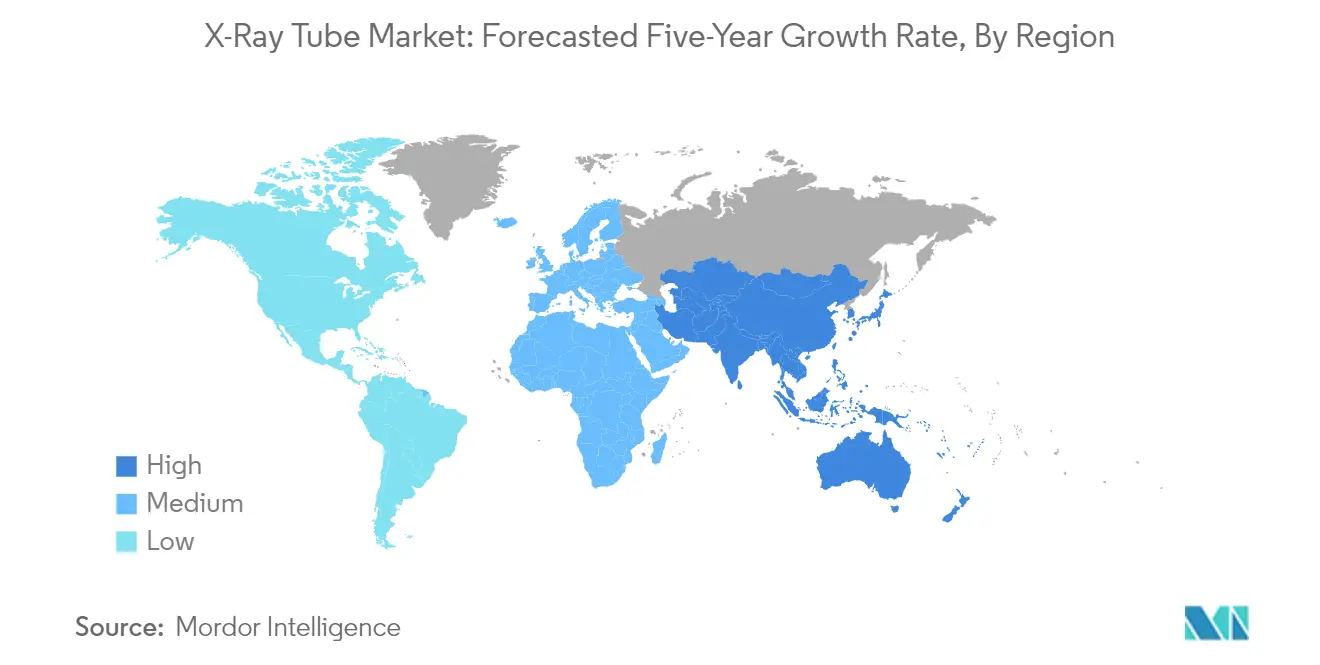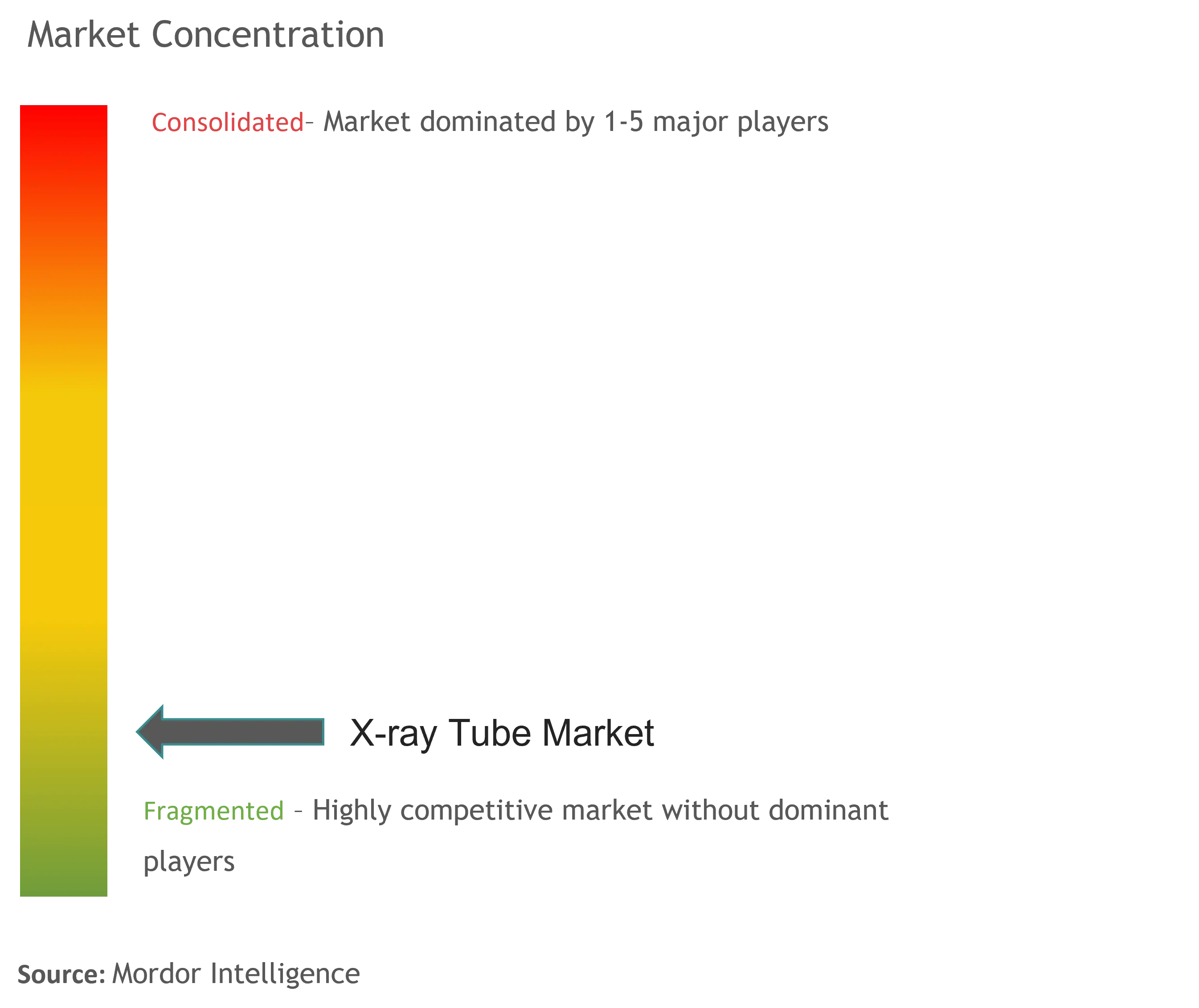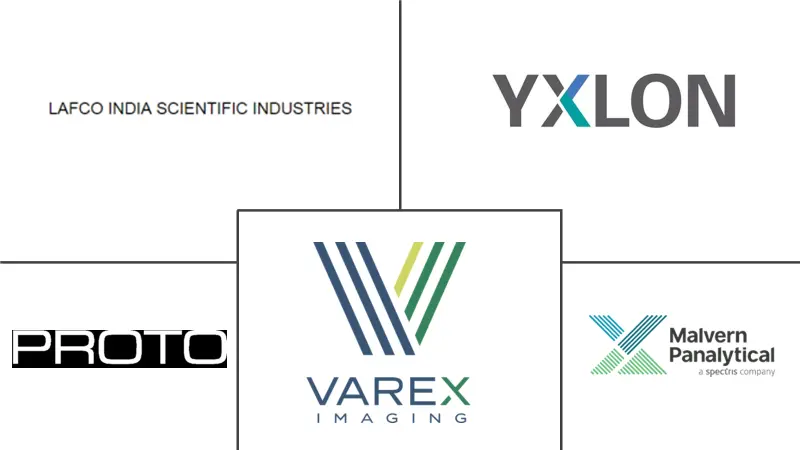X-ray Tube Market Size and Share

X-ray Tube Market Analysis by Mordor Intelligence
The X-ray Tube Market size is estimated at USD 3.63 billion in 2025, and is expected to reach USD 4.45 billion by 2030, at a CAGR of 4.19% during the forecast period (2025-2030).
The X-ray tube industry is experiencing significant transformation driven by broader industrial and technological shifts. The aviation sector's recovery has been a key catalyst, with the International Air Transport Association (IATA) reporting passenger numbers rising from 2,277 million in 2021 to an estimated 3,432 million in 2022, driving demand for security scanning X-ray equipment. This growth has led to increased installation of advanced X-ray scanning systems at airports worldwide, with major facilities upgrading their security infrastructure to incorporate state-of-the-art X-ray technology for baggage and passenger screening.
The automotive and manufacturing sectors are witnessing revolutionary changes that directly impact X-ray tube applications. The electric vehicle market's exponential growth, with sales doubling to 6.6 million units and capturing 10% of global car sales in 2021, has created new quality control requirements. Manufacturers are increasingly adopting advanced X-ray inspection systems for battery component analysis, structural integrity verification, and automated production line quality control, driving innovation in X-ray tube technology for industrial applications.
The healthcare sector continues to be a primary growth driver, with increasing diagnostic requirements across various medical conditions. According to the American Cancer Society's 2021 estimates, approximately 1.9 million new cancer cases and 608,570 cancer deaths were projected in the United States, highlighting the critical need for advanced diagnostic imaging solutions. This has spurred developments in high-resolution medical X-ray tubes, with manufacturers focusing on reducing radiation exposure while improving image quality.
The industry is witnessing significant technological advancements and strategic investments. Notable developments include Haozhi Imaging's launch of multiple carbon nanotube cold cathode X-ray source products in 2022, featuring working voltages ranging from 90kV to 165kV. Additionally, KA Imaging's USD 1.488 million investment in 2022 to develop the world's first dual-energy mobile X-ray system demonstrates the industry's commitment to innovation. These developments are particularly significant in addressing the growing healthcare needs of aging populations, with countries like China projecting their senior citizen population to reach 409 million by 2035, representing 28.5% of their total population.
Global X-ray Tube Market Trends and Insights
Technological Advancements
The X-ray tube industry has witnessed significant technological evolution since its inception, with developments focused on achieving shorter exposure times, multiple repetitive exposures, enhanced tube life, and improved load capacity. Modern innovations have led to the integration of various focal spots, faster-rotating anodes, superior anode disc materials, and the replacement of traditional glass envelopes with metal and ceramic materials. These advancements have particularly benefited the healthcare sector, where high-resolution imaging and reduced radiation exposure are crucial priorities. Notable technological breakthroughs include Siemens' Artis Q, Philips' ClarityIQ technology, GE Healthcare's Image Guided Systems (IGS), and Toshiba's Infinix Elite product line, all of which focus on delivering superior image quality without increasing radiation dose.
The development of low-energy X-ray equipment has significantly expanded their application areas, particularly in security and quality control systems across various industries. The trend toward smaller and more densely populated electronic components, along with the emergence of micro-electromechanical systems (MEMS) and micro-optoelectromechanical systems (MOEMS), has driven the development of nano-focus X-ray tube technology. This technology, defined by a focal spot of less than 1 μm in diameter, enables the detailed inspection of low-density structures and ultra-small features common in today's electronic components. Modern open-type X-ray tube technology incorporates advanced features such as true X-ray intensity (TXI) control and multi-focus X-ray capability, making it particularly valuable for inspecting packages with non-filled die attach material and thermal adhesives used in microchip assembly.
Increasing Demand for Healthcare Diagnostics
The healthcare sector's growing diagnostic needs are driving significant demand for X-ray equipment, particularly as the global population ages and chronic disease prevalence rises. According to UN data from the World Population Prospects, the world's population aged 60 years and above is projected to reach 2 billion by 2050, with 80% of this demographic residing in low- and middle-income countries. This demographic shift, coupled with the increasing incidence of chronic diseases, has led to a surge in diagnostic imaging requirements. The medical devices industry is experiencing growth in the number of imaging and diagnostic tests performed annually, driven by an increasing focus on radiological diagnostic tests and the introduction of more efficient radiological equipment through market consolidation and mergers.
The expansion of diagnostic applications has been particularly notable in dental and specialized medical procedures. According to Listerine Professional, oral conditions affect approximately 3.9 billion people globally, making dental X-ray tube imaging a crucial diagnostic tool. In the United States alone, over 30% of emergency department visits by chronically ill patients are preventable, resulting in avoidable costs exceeding USD 9 billion annually. This has emphasized the importance of early screening and diagnostic techniques, where diagnostic X-ray tube imaging plays a vital role in diagnosing various conditions, including diseases of the exocrine pancreas, lungs, bones, and abdomen. The technology's versatility extends to mammography applications, where specialized mammography X-ray tube with tungsten are employed for softer X-rays, demonstrating the adaptability of X-ray technology to meet diverse healthcare needs.
Segment Analysis: By Type
Rotating Anode Tube Segment in X-ray Tube Market
The rotating anode X-ray tube segment continues to dominate the global X-ray tube market, commanding approximately 60% of the market share in 2024. This significant market position is attributed to its superior performance characteristics and widespread adoption in high-resolution devices used for general X-ray applications, including mammography, angiography, and computed tomography (CT). The segment's dominance is further strengthened by its ability to handle higher electric loads without overheating risks, making it ideal for every radiography application. The rotating anode design, featuring advanced materials like tungsten-rhenium on molybdenum cores with graphite, enables better heat dissipation and increased durability. Major manufacturers are continuously innovating in this segment, introducing tubes with improved focal spot stability, enhanced imaging contrast, and longer operational lifespans.

Stationary X-Ray Tube Segment in X-ray Tube Market
The stationary anode X-ray tube segment is emerging as the fastest-growing segment in the market, projected to grow at approximately 4% CAGR from 2024 to 2029. This growth is primarily driven by its increasing adoption in specific applications where compact, space-saving solutions are preferred, such as dental X-ray tube units, portable X-ray machines, and portable fluoroscopy tube systems. The segment's growth is further accelerated by technological advancements in cold cathode technology and the development of more energy-efficient solutions. The simplicity of design, lower maintenance requirements, and cost-effectiveness of stationary tubes make them particularly attractive for specific medical applications and industrial inspection purposes. Manufacturers are focusing on enhancing the performance capabilities of stationary tubes while maintaining their compact form factor, driving innovation in areas such as heat management and beam focusing technologies.
Segment Analysis: By End-User Industry
Healthcare Segment in X-Ray Tube Market
The healthcare segment maintains its dominant position in the global X-ray tube market, commanding approximately 31% market share in 2024. This leadership position is primarily driven by the increasing adoption of diagnostic imaging technologies across hospitals, clinics, and specialized medical facilities worldwide. The segment's growth is further supported by technological advancements in medical imaging equipment, particularly in CT scanners, mammography systems, and digital radiography devices. The rising prevalence of chronic diseases, aging population demographics, and the continuous evolution of healthcare infrastructure in both developed and emerging markets contribute to the segment's market leadership. Additionally, the integration of artificial intelligence and machine learning capabilities in medical imaging systems has enhanced diagnostic accuracy and operational efficiency, further solidifying the healthcare segment's prominent position in the X-ray tube market.
Food Segment in X-Ray Tube Market
The food segment is emerging as the fastest-growing segment in the X-ray tube market, with a projected growth rate of approximately 7% during 2024-2029. This remarkable growth is primarily driven by the increasing implementation of stringent food safety regulations and quality control measures across the global food industry. Food manufacturers are increasingly adopting X-ray inspection systems for detecting contaminants, ensuring product quality, and maintaining compliance with international safety standards. The segment's growth is further accelerated by technological advancements in X-ray detection capabilities, allowing for more precise identification of foreign materials in food products. The rising consumer awareness about food safety, coupled with the food industry's focus on maintaining brand reputation through superior quality control measures, continues to drive the adoption of X-ray inspection systems, making this segment particularly dynamic in the market landscape.
Remaining Segments in End-User Industry
The manufacturing, aerospace and defense, and other end-user industries segments collectively represent significant portions of the X-ray tube market, each serving distinct industrial applications. The manufacturing segment utilizes X-ray tubes extensively for non-destructive testing, quality control, and material analysis applications across various industries. The aerospace and defense sector employs X-ray technology for critical component inspection, security screening, and maintenance procedures. Other end-user industries, including electronics, automotive, and research institutions, leverage X-ray tube technology for specialized applications such as semiconductor inspection, automotive part analysis, and scientific research. These segments continue to evolve with technological advancements and increasing industrial automation requirements, contributing to the overall market dynamics.
X-ray Tube Market Geography Segment Analysis
X-Ray Tube Market in North America
North America represents a dominant force in the global x-ray tube market, driven by advanced healthcare infrastructure, technological innovation, and a strong presence of major market players. The United States and Canada form the key markets in this region, with both countries demonstrating significant investments in healthcare diagnostics and medical imaging technologies. The region's growth is further supported by the increasing adoption of advanced x-ray equipment in various applications, including healthcare, manufacturing, aerospace, and security sectors.

X-Ray Tube Market in United States
The United States maintains its position as the largest market for x-ray tubes in North America, benefiting from extensive healthcare infrastructure and continuous technological advancements. With approximately 84% market share in North America's x-ray tube market in 2024, the country leads in innovation and adoption of advanced imaging technologies. The presence of major manufacturers, stringent quality standards, and increasing demand from various sectors, including healthcare, aerospace, and security applications, contribute to its market dominance. The country's focus on research and development, coupled with significant investments in healthcare infrastructure, continues to drive market growth.
X-Ray Tube Market Growth Dynamics in United States
The United States also emerges as the fastest-growing market in North America, with an expected growth rate of approximately 4% during 2024-2029. This growth is driven by the increasing adoption of advanced medical imaging technologies, rising healthcare expenditure, and expanding applications in non-destructive testing. The country's strong focus on technological innovation, particularly in developing more efficient and precise medical x-ray tube technologies, continues to create new opportunities. The expansion of applications beyond traditional healthcare into sectors such as airport security, industrial inspection, and research applications further supports this growth trajectory.
X-Ray Tube Market in Europe
Europe represents a significant market for x-ray tubes, characterized by strong technological capabilities and robust healthcare infrastructure. The region encompasses key markets, including Germany, the United Kingdom, and France, each contributing significantly to the overall market dynamics. The European market benefits from strong research and development activities, the presence of major manufacturers, and increasing adoption of advanced imaging technologies across various sectors.
X-Ray Tube Market in Germany
Germany stands as the largest market for x-ray tubes in Europe, commanding approximately 32% of the region's market share in 2024. The country's leadership position is supported by its advanced manufacturing capabilities, strong presence of major industry players, and robust healthcare infrastructure. German manufacturers are particularly focused on developing reliable and high-performance industrial x-ray tube technologies while maintaining minimal material usage. The country's emphasis on research and development, coupled with its strong industrial base, continues to drive innovation in x-ray tube technology.
X-Ray Tube Market Growth Dynamics in United Kingdom
The United Kingdom emerges as the fastest-growing market in Europe, with an expected growth rate of approximately 6% during 2024-2029. The country's market is driven by increasing investments in healthcare infrastructure, growing adoption of advanced imaging technologies, and strong research activities. The presence of key manufacturers and research institutions continues to foster innovation in x-ray tube technology. The UK's focus on developing more efficient and precise imaging solutions, coupled with increasing applications across various sectors, supports this robust growth trajectory.
X-Ray Tube Market in Asia-Pacific
The Asia-Pacific region represents a dynamic market for x-ray tubes, characterized by rapid technological adoption and expanding healthcare infrastructure. Key markets, including China, Japan, and India, demonstrate varying levels of market maturity and growth potential. The region benefits from increasing healthcare investments, growing industrial applications, and rising demand for advanced imaging technologies across various sectors.
X-Ray Tube Market in China
China maintains its position as the largest market for x-ray tubes in the Asia-Pacific region. The country's market leadership is driven by its vast healthcare infrastructure, growing manufacturing capabilities, and increasing adoption of advanced imaging technologies. China's focus on improving healthcare standards through initiatives like the Health China 2030 plan, coupled with significant investments in medical technology, continues to drive market growth. The presence of both domestic and international manufacturers further strengthens the country's market position.
X-Ray Tube Market Growth Dynamics in India
India emerges as the fastest-growing market in the Asia-Pacific region. The country's market is driven by increasing healthcare infrastructure development, growing adoption of advanced medical technologies, and rising investments in manufacturing capabilities. Government initiatives supporting domestic manufacturing and increasing focus on healthcare accessibility contribute to market growth. The country's expanding industrial sector and growing demand for non-destructive testing applications further support market development.
X-Ray Tube Market in Rest of the World
The Rest of the World market, encompassing regions like Latin America and the Middle East & Africa, demonstrates significant growth potential in the x-ray tube market. These regions are witnessing increasing investments in healthcare infrastructure and growing adoption of advanced imaging technologies. The Middle Eastern countries, particularly those with strong economies, show substantial investment in healthcare and security applications. Brazil emerges as the largest market in Latin America, while Middle Eastern countries demonstrate the fastest growth rates, driven by their well-organized healthcare sectors and increasing investments in non-oil revenue streams. The market in these regions benefits from growing economies, technological advancement, and increasing applications across healthcare, manufacturing, and security sectors.
Competitive Landscape
Top Companies in X-ray Tube Market
The X-ray tube market features prominent players like Varex Imaging, GE Healthcare, Siemens Healthineers, Philips Healthcare, and Canon Medical Systems leading the innovation landscape. These companies are heavily investing in research and development to enhance product portfolios, particularly focusing on advanced imaging technologies and specialized applications across medical and industrial sectors. Strategic partnerships and collaborations have become increasingly common as companies seek to expand their technological capabilities and market reach. Manufacturing facility expansions, particularly in Asia-Pacific regions, demonstrate the industry's focus on operational scalability and regional market penetration. Companies are also emphasizing value-added services and customer support infrastructure to maintain competitive advantages, while simultaneously developing cost-effective solutions to address emerging market demands.
Consolidated Market with Strong Regional Players
The X-ray tube market exhibits a relatively consolidated structure dominated by large multinational corporations with diverse healthcare and industrial portfolios. These major players leverage their extensive research capabilities, established distribution networks, and brand recognition to maintain market leadership positions. Regional specialists, particularly in emerging markets, have carved out significant niches by focusing on specific applications or geographic territories, though their influence remains limited compared to global conglomerates. The market has witnessed strategic acquisitions aimed at expanding product portfolios and geographical presence, with larger companies actively acquiring specialized manufacturers to enhance their technological capabilities and market share.
The competitive dynamics are characterized by a mix of vertically integrated manufacturers who produce both X-ray equipment and complete imaging systems, alongside specialized component manufacturers focusing solely on tube production. Market consolidation continues through strategic partnerships and joint ventures, particularly in developing regions where local manufacturing capabilities are being enhanced through technology transfer agreements. The barrier to entry remains high due to substantial capital requirements, complex regulatory compliance needs, and the importance of established relationships with healthcare providers and industrial customers.
Innovation and Service Drive Market Success
Success in the X-ray tube market increasingly depends on companies' ability to develop innovative solutions that address specific industry challenges while maintaining cost-effectiveness. Incumbent players are focusing on expanding their service offerings, developing more efficient and longer-lasting tubes, and creating specialized solutions for emerging applications in both medical and industrial sectors. The ability to provide comprehensive support services, including maintenance and rapid replacement options, has become crucial for maintaining market share. Companies are also investing in digital capabilities and smart features to differentiate their products and create stronger value propositions for end-users.
For new entrants and smaller players, success lies in identifying and serving underserved market segments or geographical regions while building strong technical expertise in specific applications. The increasing focus on environmental regulations and radiation safety standards creates opportunities for companies that can develop more sustainable and safer solutions. Customer concentration in the healthcare sector and the growing importance of long-term service contracts make relationship building and after-sales support critical success factors. The risk of substitution remains relatively low due to the essential nature of radiological equipment in medical diagnostics and industrial testing, though emerging imaging technologies require companies to continuously innovate and adapt their offerings.
X-ray Tube Industry Leaders
-
Varex Imaging Corporation
-
YXLON International
-
Lafco India Scientific Industries
-
Malvern Panalytical Ltd
-
Proto Manufacturing
- *Disclaimer: Major Players sorted in no particular order

Recent Industry Developments
- June 2022: Siemens Healthineers introduced Symbia Pro.specta, a CE-marked and FDA-cleared single-photon emission computed tomography/computed tomography (SPECT/CT) system with advanced SPECT and CT imaging technologies.
- April 2022: Viscom AG announced that it would present a selection of its latest microfocus X-ray tubes at Control in Stuttgart, Germany. Due to their flexibility, a previously unattainable spectrum of tasks can now be covered using the same X-ray source, from the inspection of small, filigree objects and time-optimized series inspections to the radiography of large and massive components.
- March 2022: Canon Medical Systems agreed to acquire Nordisk Röntgen Teknik (NRT), a Danish medical equipment manufacturer, to strengthen its global X-ray business. NRT develops, manufactures, and distributes advanced multipurpose X-ray fluoroscopy systems and general radiography systems. Canon Medical intends to use the acquisition to improve its technology, development, and manufacturing of advanced digital imaging solutions in Europe.
- February 2022: YXLON International launched YXLON UX 50. The product has been developed especially for the production environment, with a specific focus on the automotive and foundry industries. The availability of both line and/or flat-panel detectors is particularly suitable for CT analyses of large and dense parts, additionally offering the best results in digital radioscopy.
Global X-ray Tube Market Report Scope
An X-ray tube is a device that produces X-rays while subjected to an electric charge. The equipment consists of four parts: an anode, a cathode, a glass envelope, and a protective housing. The electrodes are placed in a vacuum-sealed glass envelope, and the charge is passed through the device. The electrons emitted at the electrode travel in a vacuum to reach the opposite electrode, thus resulting in the emission of X-rays. Since their inception, the tubes have found various applications in several industries, although the medical industry has been the primary consumer of these devices.
The X-ray Tube Market is segmented by type (rotating anode tube, stationary X-ray tube), end-user industry (manufacturing, healthcare, food, aerospace, and defense), and geography. The market sizes and forecasts are provided in terms of value (USD million) for all the above segments. The study also tracks key market parameters, underlying growth influencers, and major vendors operating in the industry, which supports the market estimations and growth rates during the forecast period. The study analyzes the impact of the COVID-19 pandemic on the ecosystem.
| Rotating Anode Tube |
| Stationary X-Ray Tube |
| Manufacturing |
| Healthcare |
| Food |
| Aerospace and Defense |
| Other End-user Industries |
| North America | United States |
| Canada | |
| Europe | United Kingdom |
| Germany | |
| France | |
| Rest of Europe | |
| Asia-Pacific | China |
| Japan | |
| India | |
| Rest of Asia-Pacific | |
| Rest of the World |
| Type | Rotating Anode Tube | |
| Stationary X-Ray Tube | ||
| End-user Industry | Manufacturing | |
| Healthcare | ||
| Food | ||
| Aerospace and Defense | ||
| Other End-user Industries | ||
| Geography | North America | United States |
| Canada | ||
| Europe | United Kingdom | |
| Germany | ||
| France | ||
| Rest of Europe | ||
| Asia-Pacific | China | |
| Japan | ||
| India | ||
| Rest of Asia-Pacific | ||
| Rest of the World | ||
Key Questions Answered in the Report
How big is the X-ray Tube Market?
The X-ray Tube Market size is expected to reach USD 3.63 billion in 2025 and grow at a CAGR of 4.19% to reach USD 4.45 billion by 2030.
What is the current X-ray Tube Market size?
In 2025, the X-ray Tube Market size is expected to reach USD 3.63 billion.
Who are the key players in X-ray Tube Market?
Varex Imaging Corporation, YXLON International, Lafco India Scientific Industries, Malvern Panalytical Ltd and Proto Manufacturing are the major companies operating in the X-ray Tube Market.
Which is the fastest growing region in X-ray Tube Market?
Asia-Pacific is estimated to grow at the highest CAGR over the forecast period (2025-2030).
Which region has the biggest share in X-ray Tube Market?
In 2025, the North America accounts for the largest market share in X-ray Tube Market.
What years does this X-ray Tube Market cover, and what was the market size in 2024?
In 2024, the X-ray Tube Market size was estimated at USD 3.48 billion. The report covers the X-ray Tube Market historical market size for years: 2019, 2020, 2021, 2022, 2023 and 2024. The report also forecasts the X-ray Tube Market size for years: 2025, 2026, 2027, 2028, 2029 and 2030.
Page last updated on:



